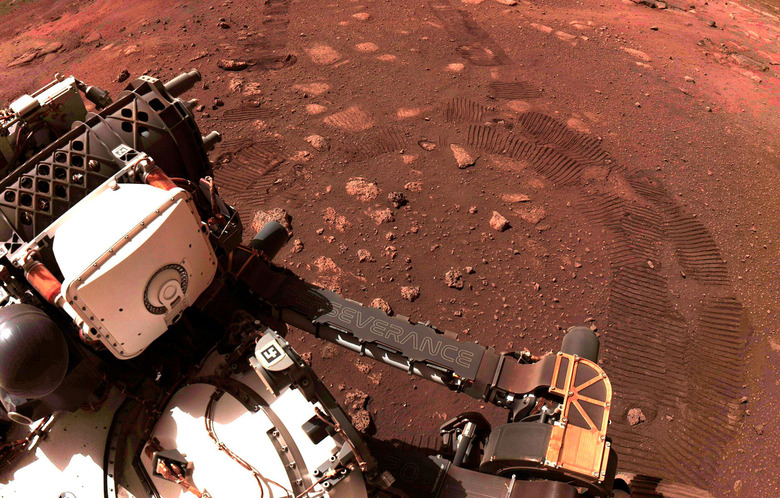NASA's Perseverance Is Dealing With Ridiculous Cold Temperatures
When you see images from the surface of Mars it looks a lot like deserts here on Earth. It's dry and dusty and barren, and on Earth, we associate that kind of environment with extreme heat. On Mars, things are pretty much the exact opposite. The planet's distance from the Sun combined with its barely-there atmosphere and total lack of surface water or vegetation means that it doesn't hold on to heat very well at all, and leads to frigid surface temperatures.
In a new post on NASA's Mars Exploration Program website, the space agency reveals the first temperature readings that its new Perseverance rover sent back. The rover has been on the planet for over a month now, and it's had to endure some ridiculously chilly weather during that time. Never creeping near the freezing mark, the daily temperatures range from a chilly high of -7.6 degrees Fahrenheit (-22C) to a low of -117.4F (-83C). Yeah, you wouldn't want to visit.
NASA is very interested in the weather on Mars for some pretty obvious reasons. Crewed missions to the Red Planet have been discussed at length, and while NASA hasn't set any plans in stone, the space agency has kicked around the idea that it may be possible to send humans to the planet sometime in the 2030s. With that in mind, it's incredibly important to understand the climate, and the most vital part of it is temperature.
NASA now has three "weather stations" on Mars in different locations. The Mars InSight lander provides temperature and other data, the Curiosity rover can also relay atmospheric conditions and temperature, and now the Perseverance rover offers a third data point whenever the space agency wants to check how the planet's temperatures are shifting.
On Perseverance, the atmospheric data is collected by the Mars Environmental Dynamics Analyzer (MEDA), which can be powered up whenever NASA wants to collect climate data. MEDA was first fired up on the day after the rover landed and collected information for roughly a half-hour. It has since collected more readings and beamed them back to scientists on Earth as the rover waits for its tiny companion, the Mars helicopter Ingenuity to get started with its flight tests.
The rover will spend around a month in the area around the helicopter, providing observations of the aircraft's progress in achieving manmade powered flight on another planet for the first time. Once that's done, the rover will be able to begin its scientific explorations of Mars in earnest and NASA gets to decide what features of the Jezero crater it wants to investigate first. The mission will also include sample collection, with the rover snatching material from the surface and preparing it to be picked up at a later date.
